Guide to Gibson Adjustable Saddles for Acoustic Guitars
From the late 1950s and into the 1970s, some Gibson saddles and Epiphone saddles were height adjustable saddles with cutout edges, either in ceramic or wood. That saddle type has resurfaced in later years on reissue models, although the factory saddles are now made of Tusq. At first glance, these saddles appear to be the same, but spec and shape differences appear, and so while these are sometimes interchangeable, note that changing between the different types can result in action changes, particularly with wooden saddles. You must measure your current saddle’s length, maximum height, bass to treble height difference, and thickness before ordering a replacement.
You will hear tonal differences from the different materials, and may find minor intonation differences due to subtle shape differences. In this article we will discuss the common cutout edge height adjustable saddle types, and how to find a replacement.
This article only applies to cutout edge height adjustable saddles. Please see our article on How to Find the Correct Height Adjustable Saddle for information on flat or round edge height adjustable saddle types.
Also, a height adjustable saddle differs from an intonation adjustable bridge, similar to what’s found on electric guitars, but placed on an acoustic. The best-known of these was the Gibson Tune-o-Matic. Please see this video for more information. The height adjustable and Tune-O-Matic inserts have different specs and are not interchangeable. The Tune-O-Matic inserts are often about 3 to 4 mm thicker, made with a slightly overall longer overall length, and different post spacing. Also, Tune-O-Matic inserts will vary depending on year and manufacturer.
High Gloss Ceramic Saddles
From the late 1950s and into the 1960s, Gibson used high gloss ceramic saddles. The high gloss saddles have a rising mound shape for the section where the strings sit. Pattern was center line non-compensated.
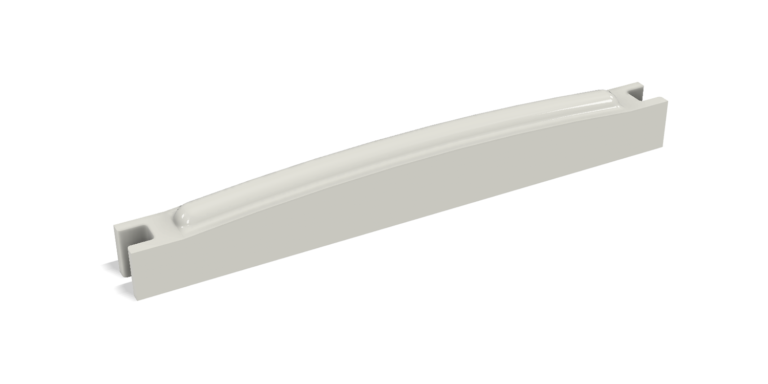

These saddles have a cut out section in the bottom, as shown in the below image, to rest the saddle on a metal plate with a corresponding bulge to fit into the saddle. This is the only adjustable saddle type that had the cut out section in the bottom.
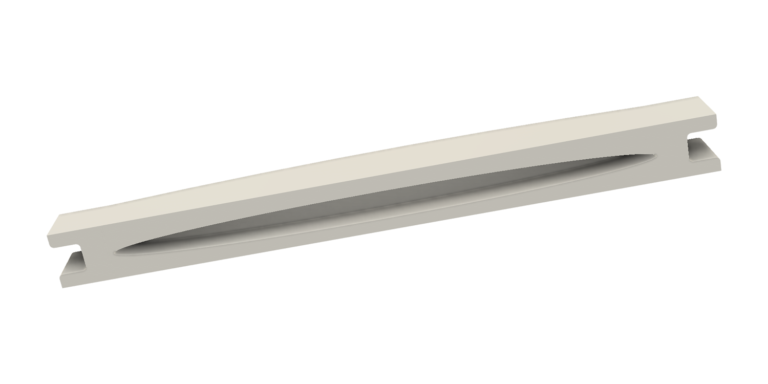
Finding a replacement high gloss ceramic saddle, whether original or aftermarket, will prove difficult. Try Ebay.com or Reverb.com. Expect to pay over $100 for an original, and perhaps much more.
Aftermarket options are also difficult to find. Please see the following link for images of an aftermarket saddle: Gibson Style High Gloss Ceramic Saddle.
Matte Ceramic Saddles
During the mid-1960s, Gibson used a matte finish ceramic saddle. These saddles had an elongated pyramid shape where the strings would sit. The bottom did not have a cut out section.
Later saddles made of Tusq or bone often also have this same elongated pyramid shape, as in the below bone saddle images.
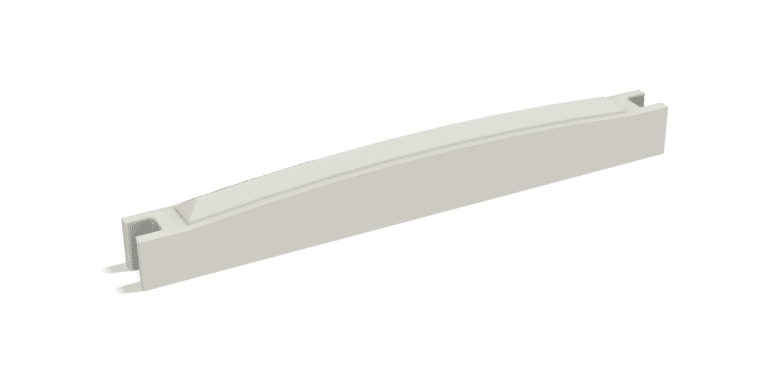
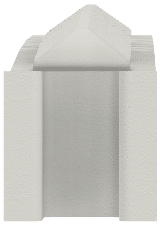
Shifting from a pyramid saddle to one of the rounded profiles, or vice versa, might result in a small scale length change, which could produce subtle intonation changes.
Pattern was center line non-compensated. Finding an original matte finish saddle will be slightly easier than finding a high gloss version, but will still prove difficult. Plan to pay over $100.
Wood Adjustable Saddles
Later in the 1960s, rosewood adjustable saddles appeared. These saddles often had an inverted U shape where the strings sat as in the below images.
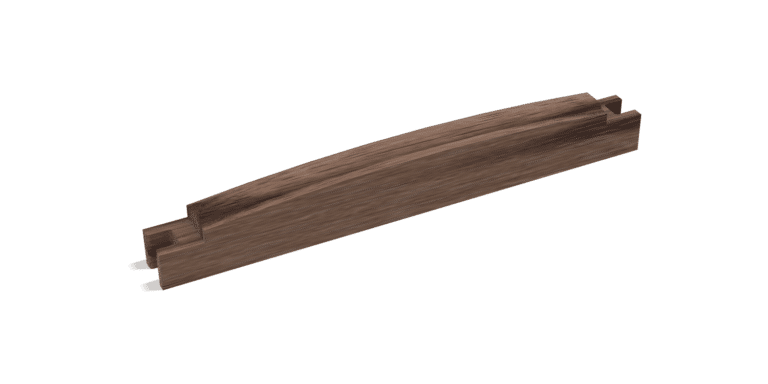
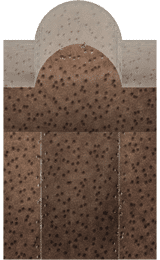
The pattern was typically center line non-compensated, but rare instances of center line B compensated adjustable saddles appear, although we do not know whether these are aftermarket or not.
Wood saddles are often 1 to 2 mm taller than their ceramic and Tusq counterparts are, and so you may not be able to replace a wood saddle with a ceramic or Tusq one as these could be too short and result in buzzing. Ensure that you measure your wood saddle’s height before ordering a replacement. You can find original wood saddles, but these will typically be worn, and might have deep gouges for where the strings rest. Expect to pay over $70 for an original.
Tusq
Gibson reissue models use a Tusq adjustable saddle, which has a similar elongated pyramid shape to what the matte ceramic saddles had. Note that these Tusq saddles have a 14 inch top radius, and have a 0.7 mm bass to treble edge height difference.
Bone
To our knowledge, Gibson has never used bone height adjustable saddles from the factory, although you will find aftermarket options online. We offer four different aftermarket options in bone: Pyramid Center Line Non-Compensated, Rounded Back Center Line Non-Compensated, Rounded Back Center Line B Compensated, or Step Compensated. These have the same length, maximum height, bass to treble height difference, thickness, and radius, but differ in compensation pattern or back side angle. Let’s review each.
Pyramid Center Line Non-Compensated
This saddle type is similar to the matte finish ceramic saddles of the 1960s, and the current Tusq saddles.
Let’s view an image of this pattern looking down on the saddle top. The saddle is at a five degree angle, which serves as a form of compensation. The thin blue line shows approximately where each string sits on the saddle top, but this will vary depending on bridge string spacing.

If you currently have this type of compensation pattern and are satisfied with your intonation, then please see this link Gibson-style Adjustable Bone Saddle – Pyramid Non-Compensated to purchase. Please note that we make these similar to the original Gibson saddles with the sharp angles on either side of where the strings rest on the saddle top. We do this because customers often want saddles that match their original factory parts.
However, some customers prefer not having the sharp angle on the back side where the strings go down toward the bridge pin holes. This can cause string grooves and string breakage. Please see the following link and scroll to the bottom for more information on this: Saddle Angle and Compensation.
As such, for these customers we also offer this saddle with a rounded back as shown in the below image, which looks at the saddle from the bass edge.
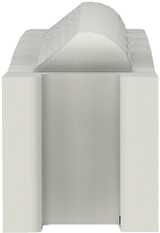
To purchase this saddle, please see the following link: Gibson-style Adjustable Bone Saddle – Rounded Back Non-Compensated.
Additional Compensation Patterns
Please note that the additional compensation patterns shown in the next two saddle types do not necessarily improve intonation. Saddle compensation will have an effect on intonation, but this could have a positive or negative effect depending on your specific guitar. Please check your current intonation to determine which pattern would work best for you. If you are not sure about this, please contact a guitar technician.
Center Line B Compensated
This is an aftermarket pattern that we offer in bone but it never appeared on factory models. This pattern is much like the rounded back center line non-compensated saddle, but the B string sits farther back toward the bridge pins, as shown in the below image.

If you currently have a center line non-compensated saddle, but your B string is sharp, consider this saddle type. Please note that this will not necessarily correct your B string being sharp, but might help by lengthening the scale length slightly. Please see the following link to purchase this saddle type: Gibson-style Adjustable Bone Saddle – Center Line B Compensated.
Step Compensated
This is another aftermarket saddle pattern that we offer in bone. This pattern is similar to the center line B compensated saddle, but the A and bass E strings sit progressively farther back toward the bridge pins, as shown in the below image.

If you currently have a center line non-compensated saddle, but your B, A, and bass E strings are sharp, consider this saddle pattern type. Please note that this will not necessarily correct these strings from being sharp, but might help by lengthening the scale lengths slightly. Please see the following link to purchase this saddle type: Gibson-style Adjustable Bone Saddle – Step Compensated.
Timbre Differences
As expected, the different materials will produce a different timbre. For a video demonstration of different materials, please see this video.
Wood Inserts
Some guitar owners prefer to remove the adjustable saddle entirely, including the metal parts, and replace with a wood insert that has a smaller bone saddle. Please note that none of the saddle sizes discussed above will work for this purpose. For more information on wood inserts, please see this video.
What Adjustable Saddle Does Your Gibson or Epiphone Need?
Still wondering which adjustable saddle your guitar needs? Please send us all of the following information.
- Saddle Edge Type
- Fretboard Radius
- Current Saddle Length, Maximum Height, Thickness – Must be measured with a caliper
- Bass to Treble Height Difference
- Guitar Saddle Slot Length, Thickness (if different from saddle specs) – Must be measured with a caliper
- String spacing at the bridge
- Current Saddle Compensation Pattern (please send a picture if you are not sure what type you have).
